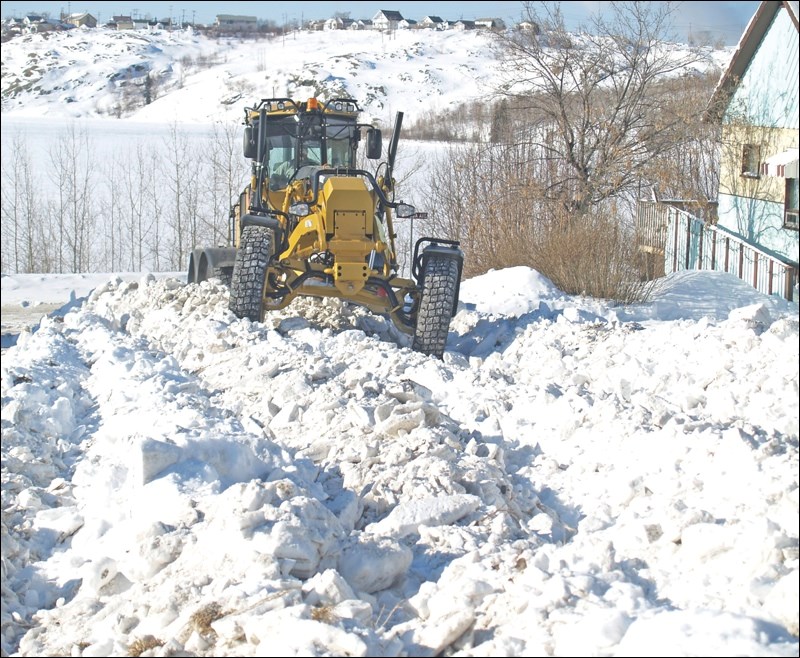Concerns over snow crews plugging up driveways and possibly working inefficiently have city council examining how the white stuff is cleared from Flin Flon streets.
At Tuesday’s council meeting, three residents and one councillor spoke of perceived problems with municipal snow clearing and removal.
“For the residents on the street, it’s quite often hard to get in and out of your driveway [after crews leave],” Anne McLaren, a Dadson Row resident, told council.
Coun. Leslie Beck said she understood the concern.
“I know exactly what you’re talking about,” she said. “When the sand truck comes down…it just pushes the snow sideways, so for myself, it just plugs my driveway and I don’t have any other access.”
Beck said she spoke with Chief Administrative Officer Mark Kolt about how the sand truck is used.
“I think through our conversation there’s going to be some more education,” she said, “as to how – when we have a heavy snowfall and they’re just trying to get through with the sand truck, how that works going forward.”
Patty Korchinski, who lives on Dadson Row, spoke of an incident earlier this winter in which the city sand truck got stuck in the snow one day followed by the garbage truck the next.
“So if your vehicles are getting stuck on that street, what about the people that are living there?” she said.
Korchinski also shared an incident in which the city grader truck got stuck on Dadson Row and then drove away. Next, work to clear the sidewalk was done.
Workers returned again to place all of the snow into the middle of the cul-de-sac, she said, and came back one more time to haul it away.
“So in total they were on our street four times,” Korchinski said. “It just concerns me that it takes four times for reasonable snow removal, and if it takes four times on my street, it’s probably taking four times on other streets, and that’s, I’m sure, pretty costly. And if we’re trying to reduce costs, it doesn’t make sense to do a job that needs to be done four times.”
Mayor Cal Huntley explained the city’s process for clearing roads, with the main routes, Main Street, which is a provincial highway, and bus routes given top priority.
“What it sounds like to me is they were trying to get [Dadson Row residents] moving,” he said, “so they had time to whip in with the truck and go around and open up [the area] and then go [elsewhere], because the residential areas are not a high priority.”
Huntley said city crews can’t always remove snow right after it is cleared, so it will remain on site until there is time to haul it away.
The problem with that, Korchinski said, is that the initial work “almost makes it worse.”
Coun. Colleen McKee said she discussed Korchinski’s concerns with Director of Works and Operations Charles Boulet.
She said she was told factors at play included back-to-back heavy snowfalls, limited resources due to workers taking holidays before Christmas, and the priority given to major traffic routes.
McKee also said Boulet spoke of working with a finite snow-clearing budget that has to last all winter.
“I think it’s just a matter of being able, or trying to, manage those things,” she added.
But there were more concerns. McLaren told council she had called the city to ask them to stop sending a blade-equipped sand truck down Dadson Row when there was no more snow left to clear.
She said she watched the truck go down the street three times in a day, even though back alleys still needed plowing.
McLaren said she and her neighbours were baffled.
“We couldn’t understand what they were doing, and they would keep continually going up the same street they’ve been up,” she said.
Another resident, Henry Wolf, spoke of city trucks creating snow ridges and, last year, needlessly spreading sand on snow banks on back lanes.
Huntley thanked the residents for their feedback during what was a respectful exchange among all concerned.
“We have a little work to do,” he said. “The one thing I will say is, with regards to snow removal we’re always going to have complaints and we’re not going to keep everybody happy. But we appreciate you letting us know when it looks like there’s a use of resources in an ineffective way, because we do want to look for opportunities to do that better.”




